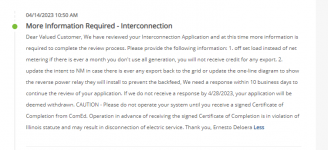Hello,
I received feedback on the interconnection application, and they recommended that the single-line diagram be updated to reflect the REVERSE POWER RELAY that will be installed to prevent back feed. In the past, I never used the Reverse Power Relay.
Could anyone be familiar with this equipment and help with the model numbers or brands for residential/commercial projects? So that I can use it in one of our projects.
I tried to find the lists on the ComEd portal but was unable.
I really appreciate any help you can provide.
I received feedback on the interconnection application, and they recommended that the single-line diagram be updated to reflect the REVERSE POWER RELAY that will be installed to prevent back feed. In the past, I never used the Reverse Power Relay.
Could anyone be familiar with this equipment and help with the model numbers or brands for residential/commercial projects? So that I can use it in one of our projects.
I tried to find the lists on the ComEd portal but was unable.
I really appreciate any help you can provide.


